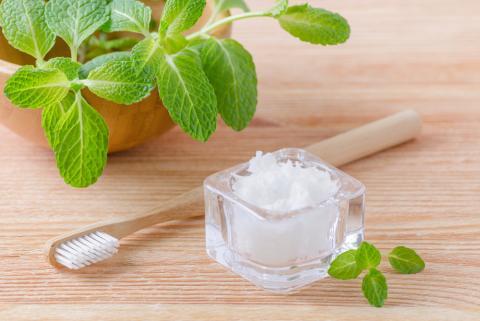
Brushing your teeth with conventional toothpaste can do more harm than good. That's because conventional toothpaste has a bunch of questionable ingredients. Want to create a more natural, holistic dental care routine? Here's how to ditch conventional products and get a holistic dental care routine down.
Why choose a holistic dental care routine?
At one point, microplastics were found in toothpaste, resulting in public outrage and a microplastic ban in all toothpastes. Isn’t that gross? But there are other ingredients lurking in conventional dental care products that are still potentially bad for you—and the environment. One of them is triclosan, a toxic ingredient in antibacterial products that was banned from soaps by the FDA. Unfortunately, triclosan can still be found in toothpaste, which is a problem considering it is highly toxic and has been linked to immune and endocrine issues. The same can be said for conventional mouthwash which often contains questionable ingredients you cannot even pronounce.
That’s why having a holistic dental care routine is so important. It cuts out the risks that come along with conventional products. There’s also the environmental aspect to consider: Most conventional dental products are packaged in plastic. In fact, toothbrushes are made out of plastic completely. They all end up in the landfill, or worse, our oceans. Plus, plastic leaches toxins the longer it sits around, which can harm both humans and animals. Do you really want something like that anywhere near your mouth (yes, I’m looking at you, plastic toothbrushes)? Making the switch to a more holistic dental care routine will help your health and the planet. Here’s how to do it.
Homemade Toothpaste
First up, make the switch to homemade toothpaste. It’s really easy to make your own homemade toothpaste and it saves you a buck, too. My favorite homemade toothpaste is basically just a mix of coconut oil, baking soda and peppermint essential oil. I usually use about 4 tablespoons of coconut oil, 3 tablespoons of baking soda, and 25 drops of peppermint essential oil. I combine them in a bowl, mix with a spoon, and then pour it into a small glass jar. To use it, dip your toothbrush in it and then brush your teeth as normal.
It takes a while to get used to the texture, taste, and consistency of the blend, but it’s not bad at all. If you choose, you can add a little stevia for a slightly sweeter toothpaste. The toothpaste is kind of liquidy and then solidifies a bit more as time goes on. This is completely normal and doesn’t mean it won’t work. If you prefer a more solid toothpaste, let it sit in the fridge for at least 30 minutes to harden.
Natural Mouthwash
Making your own all-natural mouthwash is really simple. You can use any emptied-out glass bottle to store it in. Just make sure you wash it out really good before putting any of your homemade mouthwash in it.
There are several recipes online for DIY mouthwash worth checking out, but my personal favorite is very simple and effective. Take one to two sprigs of mint, boil it in water, add a few drops of peppermint and tea tree oil, add some baking soda, and add it to a bottle of your choice. As far as measurements go, it all depends on how big your bottle is. As a general rule, use about 3 cups of distilled water, 1 tablespoon of baking soda, and 10-20 drops of essential oils (each). Use a funnel to pour the mouthwash into the bottle—if your bottle isn’t big enough to fit all of it, disperse it into other bottles.
You can use this mouthwash the same way you would conventional mouthwash: Just gargle and spit! If you use tea tree oil, make sure not to swallow any of this mouthwash, despite it being natural (as tea tree oil should never be ingested—even though it’s great for dental health).
Bamboo Toothbrushes
Who wants to put plastic into their mouths? I’m a firm believer my plastic toothbrushes were the reason I kept developing canker sores inside my mouth. It happened so frequently, it was almost ridiculous. I made the switch to bamboo toothbrushes and wow—what a difference. Now the occasional canker sore is just that—occasional.
Aside from the health aspects of switching to a toothbrush with less plastic, there’s the environmental aspect too. Toothbrushes need to be replaced every four months, so while they’re not single use, they’re still pretty ephemeral. Can’t say you still use the same toothbrush since you were a kid, right? Well, unfortunately, that means they become waste and end up in our landfills or our waterways. In fact, over 4.7 billion plastic toothbrushes are produced every year worldwide. That’s a lot of waste, and, considering it’s not recycled and does not break down, it’s not going anywhere any time soon. So do yourself a favor and make the switch to a bamboo toothbrush. Look for one with certified organic bamboo in the handle, which can be composted at the end of its life. Check to be sure the bristles aren’t entirely plastic—one popular brand is made from 62 percent castor bean oil and 38 percent plastic, for example. Unfortunately, the bristles need to be removed and wind up as a waste product, but I’d rather waste only the bristles rather than an entire toothbrush.
Compostable Dental Floss
Did you know dental floss is made from plastic, then coated in wax? It’s completely unrecyclable. Plus, again, why would you want plastic so close to your gums and teeth? After everything we’ve discussed (as in plastic leaching toxic chemicals), I think I’ll pass. Instead, make the switch to compostable dental floss. And don’t forget about the packaging: some brands feature a little cardboard box you can compost or recycle. Others provide refills for the container, so you don’t have to buy an entirely new “case” for each spool of floss. This is so much better for your health and the environment. It’s nice to know that even if you do flush this floss down the drain, it won’t harm the ecosystem nearly as much as conventional floss. Plus, you can find brands that are waxed and minty, just like conventional floss! You’re not sacrificing anything when you make the switch.
Want more ways to make your dental care routine holistic and plastic free? Try whitening your teeth naturally, using a tongue scraper, doing oil pulling, or utilizing herbs to stop tooth decay. Happy brushing!








